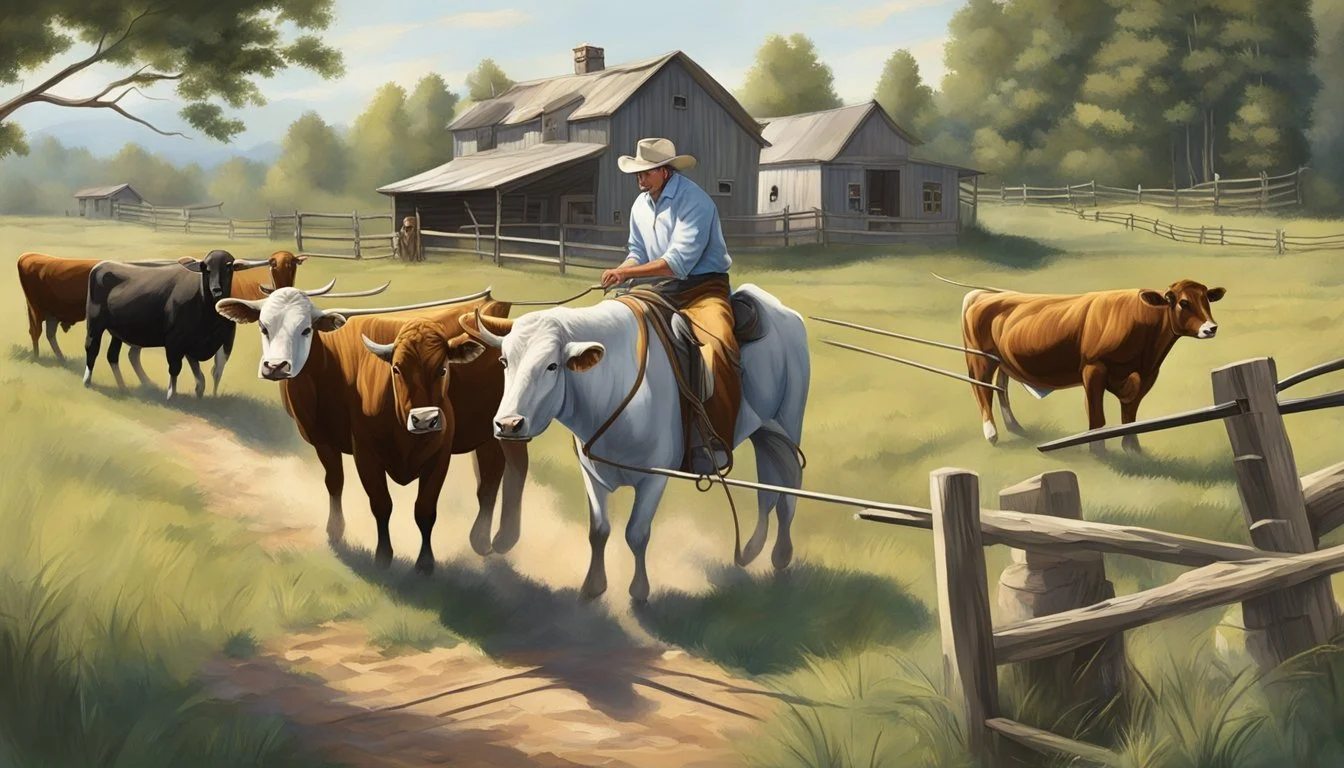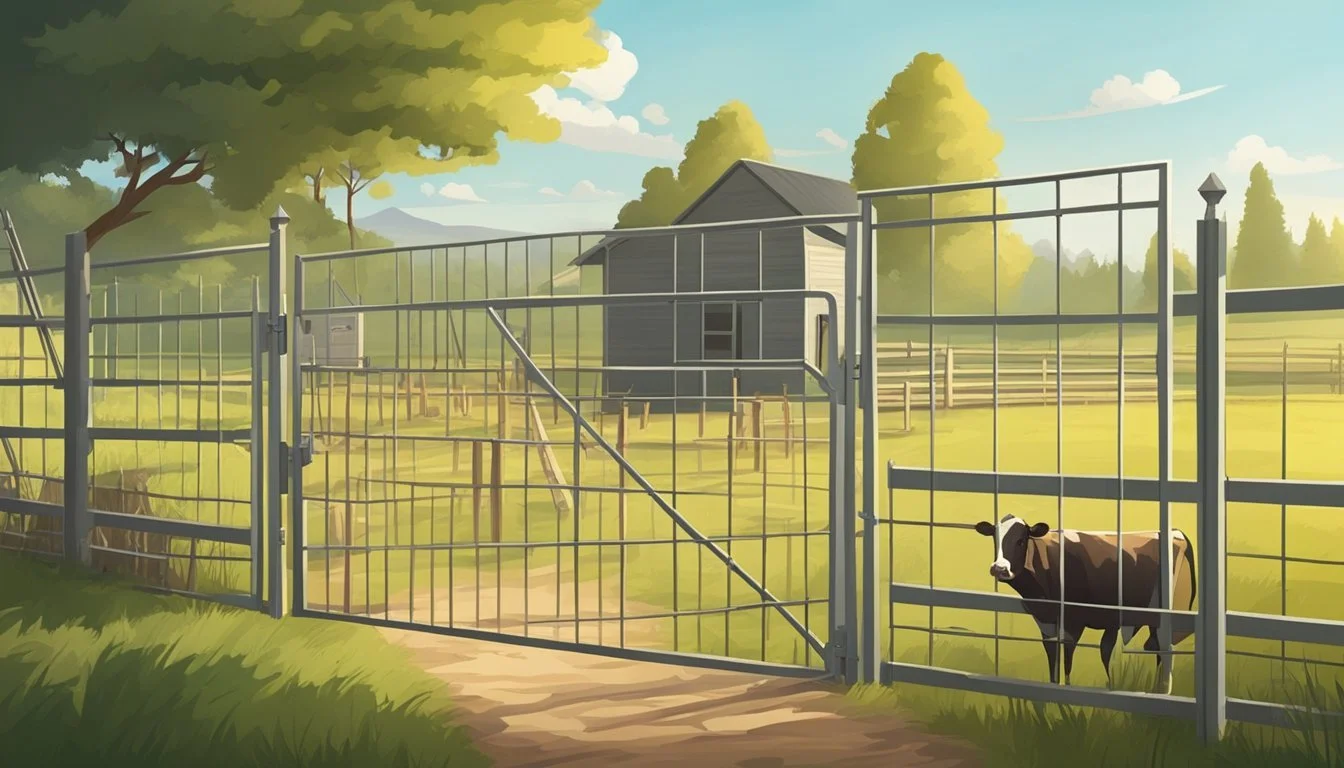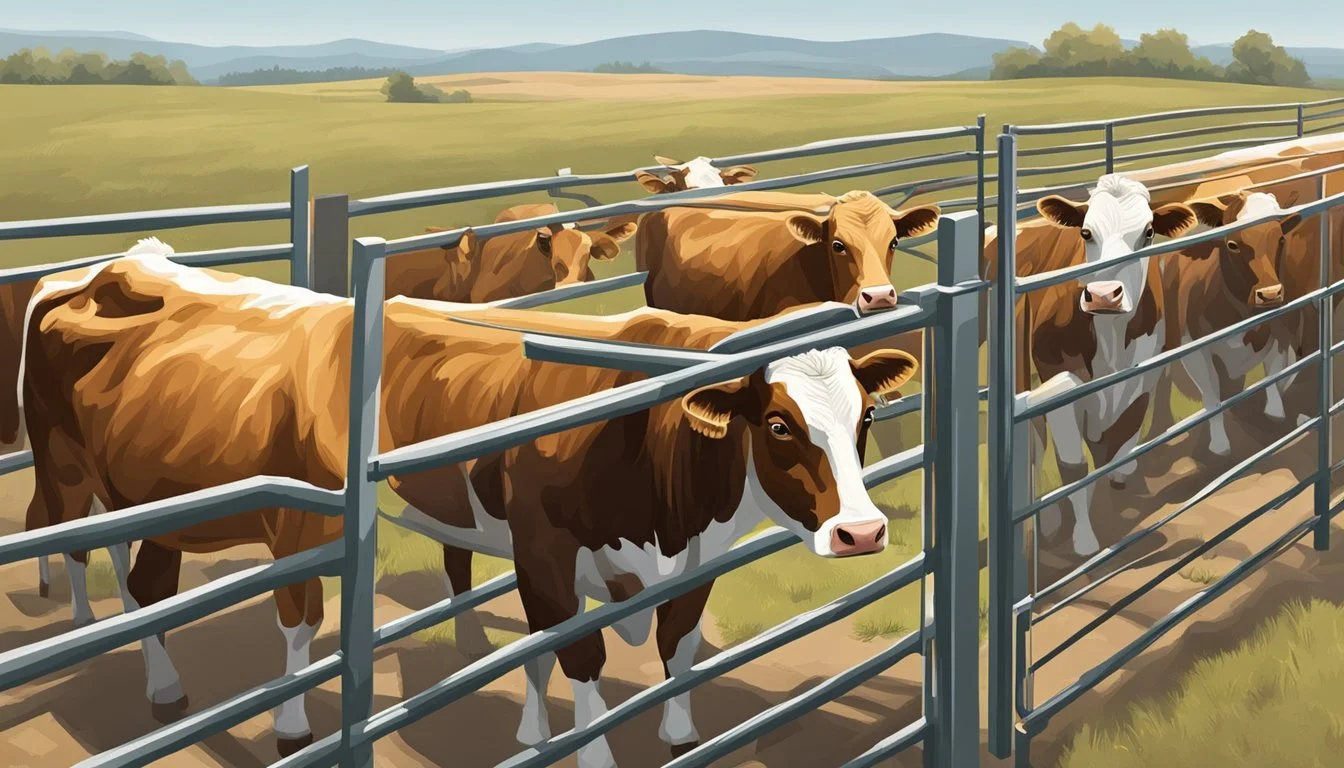The Ultimate Guide to Using a Cattle Prod
Ensuring Safe Livestock Movement on Homesteads
For those managing livestock on a homestead, ensuring the safe and efficient movement of animals is a priority. The cattle prod is a tool that, when used responsibly, aids in guiding livestock, offering a practical solution to encourage movement during handling and transport. These devices operate by emitting a mild electric stimulus that gently prods the animal in the desired direction, facilitating the process with minimal stress.
Understanding the principles of using a cattle prod appropriately is vital for the welfare of the animals. Adequate use of these tools demands knowledge of both the equipment and the livestock's behavior. Modern cattle prods are designed with safety features to minimize harm, but it remains crucial for users to acquaint themselves with the guidelines that govern their usage to ensure they are employed in a way that is effective, yet humane.
It is important to have clear protocols for moving animals, recognizing that the goal is to minimize the reliance on electric prods, ideally using them as a last resort. Alternative methods for directing and motivating livestock should always be considered first, ensuring electric prods are not substituted for proper handling techniques. When they are used, careful attention must be given to the frequency and context of application, always aligning with best practices for animal welfare.
Basics of Livestock Movement
Before herding livestock on a homestead, it is essential to understand the behavior of the animals and to apply principles of safe herding to ensure their welfare and the efficiency of the process.
Understanding Livestock Behavior
Livestock, such as cattle, inherently display certain behaviors that influence how they should be moved. They tend to move in herds as a survival mechanism, following a leader or flowing with the group. Recognizing this herd behavior is crucial for effective movement. Cattle have a flight zone, an invisible boundary around them, which when entered, prompts the animal to move away. The size of this zone varies with each animal, and it is affected by their tameness or wildness.
Key Aspects of Livestock Behavior include:
Herd Instinct: A natural tendency to stick together for security.
Flight Zone: An animal’s personal space that, when invaded, will cause it to move.
Point of Balance: Typically located at the animal's shoulder and used to direct movement.
Visual Capability: Livestock have a panoramic field of vision with blind spots directly in front and behind them.
Principles of Safe Herding
Safe herding requires patience, planning, and a non-confrontational approach to direct animals from one place to another. The handler's movements should be deliberate and calm to avoid spooking the livestock and potentially causing a hazardous situation.
Essentials for Safe Herding:
Calm and Slow Movements: Eliminates stress for the animals and prevents accidents.
Understanding of Animal Senses: Using knowledge of their sight and hearing to guide them effectively.
Minimal Use of Force: Utilizing techniques that encourage natural movement rather than force.
By taking into account these behavior patterns and herding principles, one can move livestock efficiently on a homestead with minimal stress placed on the animals.
Cattle Prod Essentials
When selecting a cattle prod, understanding its types, components, and how to choose the appropriate one ensures both the safety of the livestock and the handler.
Types of Cattle Prods
Cattle prods, also known as electric prods or stock prods, are categorized primarily by their power source and design. The two main types are:
Handheld Prods: These are traditional and commonly used for direct contact. They require the handler to be close to the animal.
Shaft Prods: These have a longer shaft, allowing the handler to maintain a safe distance. The length of the shaft can often be chosen based on the specific needs of the livestock and the situation.
Parts of a Cattle Prod
A cattle prod typically consists of:
Shaft: It varies in length, typically between 24 to 60 inches, to accommodate different animal sizes and handler preferences.
Handle: Usually designed to be non-slip and comfortable to hold during use.
Battery: Either replaceable or rechargeable, the battery powers the electric current needed to motivate the cattle.
Tip/Electrode: Delivers a controlled electric shock when it comes into contact with the animal.
Selecting the Right Cattle Prod
Choosing the right cattle prod involves several key factors:
Animal Size: Larger animals may require a prod with a longer shaft for safe handling.
Task at Hand: Different tasks might require varying prod designs; for example, moving animals through a chute might require a different type than open-field work.
Power Source: Consider whether a rechargeable battery is more suitable for your needs versus replaceable batteries for ease of use and maintenance.
The appropriate selection and responsible use of cattle prods contribute to effective livestock management.
Effective Use of Cattle Prods
Cattle prods are a significant tool for the effective and safe movement of livestock. Mastery in their use culminates from adherence to best practices and thorough training while steering clear of common handling errors.
Best Practices in Handling
The cornerstone of using cattle prods is humane treatment. Operators should ensure minimal use, employing prods only as needed to guide or encourage movement of stubborn or hesitant animals. They must remain vigilant in recognizing signs of stress in livestock and respond appropriately to avoid overuse of these devices.
Minimize Contact: Aim to use the prod for less than 1-5% of cattle, and only as a last resort.
Proper Contact Points: The prod should be used on the hindquarters of the animal, never on sensitive areas such as the face or genitalia.
Training for Proper Use
Training is crucial for handlers to become proficient with cattle prods. They must understand the equipment's mechanics, the appropriate level of stimulus, and the timing of prod usage to ensure control is maintained without unnecessary stress to the animals.
Hands-on Training Sessions: Handlers should participate in supervised training to gain practical experience.
Safety Protocols: Clear guidelines must be established to ensure both handler and animal safety.
Avoiding Common Mistakes
Common mistakes in the use of cattle prods often stem from insufficient training or disregard for best practices. Here are frequent errors to avoid:
Overuse: Excessive use of prods can cause stress and injury to livestock.
Inappropriate Use: Using a prod on calves, non-ambulatory animals, or as a punitive tool is unacceptable and counterproductive.
By implementing these practices and avoiding errors, handlers can use cattle prods effectively to manage and control livestock while ensuring their welfare.
Safety and Welfare Considerations
When using a cattle prod, it is essential to prioritize the welfare of the animals while also considering the safety of the handler. The goal is to effectively guide livestock with minimal stress and pain.
Minimizing Stress and Pain
A cattle prod should only be used as a last resort when other herding methods are unsuccessful. Handlers should be trained to use the device in a way that applies the least amount of stress to the animal. They must ensure:
Brief contact: Short, controlled touches rather than prolonged contact.
Low intensity: Use the lowest effective shock setting to prompt movement.
Design Features for Safety
Modern cattle prods include design aspects specifically aimed at preventing injury and reducing pain for livestock. Key safety features include:
Insulated handles: To protect the user from accidental shocks.
Controlled voltage: Regulated voltage output ensures a safe, consistent stimulus.
Tip design: Specifically crafted to make contact with the animal's hide without causing cuts or punctures.
Regulations on Animal Welfare
There are established guidelines and laws that govern the use of cattle prods, ensuring the safety and well-being of the animals. Handlers should be aware of:
Usage protocols: Legally defined situations where the use of a cattle prod is deemed appropriate.
Training requirements: Mandatory training prerequisites for all handlers to reduce risks of misuse.
Maintenance and Upkeep of Cattle Prods
Proper maintenance and regular upkeep are crucial for ensuring the durability and effectiveness of cattle prods. These practices not only extend the life of the tools but also guarantee safety and reliable performance during use.
Routine Care and Cleaning
Regular cleaning of the cattle prod is essential. After each use, the farmer should detach any detachable parts and wipe down the surface of the prod with a dry cloth to remove dirt and debris. Special attention should be given to the electrodes, as buildup can inhibit performance. It is advisable to avoid harsh chemicals that could damage the prod's material.
Dealing With Wear and Tear
To maintain the prod's durability, one must inspect it periodically for signs of wear and tear, such as cracks or breakage. Replace any worn parts immediately to prevent malfunctions. Farmers should follow the manufacturer's guidelines on servicing to ensure that all components remain in good working condition.
Battery Management
Effective battery management is a key aspect of cattle prod maintenance.
For rechargeable batteries:
It is imperative to follow a regular charging routine to ensure the battery does not deplete fully as this can shorten its lifespan.
Store the batteries in a cool, dry place and avoid exposing them to extreme temperatures.
For non-rechargeable batteries, they should be replaced promptly when power levels are low. Disposed batteries must be handled according to local regulations to minimize environmental impact.
Advanced Tips and Techniques
Incorporating advanced techniques into livestock management can greatly enhance efficiency and productivity. These methods leverage technology, tackle handling difficulties, and strategize to increase farm outputs.
Utilizing Technology for Efficiency
Farmers can drastically improve their efficiency by incorporating modern technology into their cattle prod usage. Electric cattle prods can now connect to smartphone apps that help track the movement of livestock and monitor the frequency and location of prod usage, ensuring a humane approach. Additional technological advances include:
GPS Tracking: This helps in monitoring the position of livestock across diverse terrains, contributing to more streamlined herding processes.
Adjustable Voltage Settings: They allow handlers to tailor the electric output based on the size and temperament of the livestock, promoting better animal welfare.
Handling Challenging Scenarios
In dealing with more stubborn or resistant animals, proper technique is key to ensure safety and effectiveness. Handlers should:
Position Themselves Safely: Maintain a position that keeps them out of reach of kicks or unexpected movements.
Apply Brief Contact: Use short, controlled contact with the prod to guide rather than force animals into moving.
It's essential to recognize signs of stress in livestock and adjust tactics accordingly to reduce potential harm or distress.
Improving Farm Productivity
Productivity on the farm can be improved not just by managing the livestock effectively, but also by optimizing the use of cattle prods. Handlers must:
Regularly Maintain Equipment: Ensuring that all cattle prods are in good working condition before use prevents delays and inefficient handling.
Train Staff: Knowledgeable staff who are well-versed in both the technology and animal behavior can execute livestock management tasks more efficiently.
By following these advanced tips and techniques, farmers can ensure that they are using cattle prods in the most effective manner possible, thereby improving their overall farm operations.
Choosing Equipment Beyond Cattle Prods
When managing livestock on a homestead, the use of cattle prods is just one aspect of a larger system of tools and procedures. It's essential to consider alternative methods for animal guidance, supplementary devices that provide assistance, and the importance of investing in high-quality gear for both effectiveness and animal welfare.
Alternatives to Electric Prods
There are methods available that do not rely on electric stimulation to move livestock. These include:
Flagging: Using brightly colored flags to catch attention and guide animals.
Herding Dogs: Trained dogs can be effective for encouraging livestock to move in a desired direction.
Pressure and Release Techniques: This involves applying and relieving pressure in the animal's space to prompt movement.
Supplementary Tools and Equipment
In addition to non-electric alternatives, the following implements can aid in directing livestock safely and efficiently:
Sorting Paddles: Often used as an extension of the handler's arm, these paddles can help move animals without physical contact.
Gates and Pens: Properly designed layouts contribute to smooth livestock movement and can reduce stress and the need for prods.
Barrier Tapes and Panels: Temporary or permanent barriers can help funnel animals towards or away from specific areas.
Investing in High-Quality Gear
Quality is paramount when selecting tools for livestock handling. High-quality equipment is more likely to be:
Durable: Long-lasting materials prevent frequent replacements and ensure safety.
Effective: Premium tools perform their intended function without unnecessary stress to the animals.
In summary, when choosing equipment for moving and handling livestock, homesteaders should consider various non-electric alternatives to cattle prods, utilize a range of supplementary tools, and prioritize the investment in high-quality gear to promote humane practices and operational efficiency on their homestead.
Ethical and Responsible Herding
In ensuring the ethics and responsibility of herding, it is crucial to balance humane treatment of livestock with effective handling techniques. This section navigates the measures to maintain livestock comfort while adhering to established ethical standards.
Understanding Animal Sensitivities
Livestock possess specific sensitive areas and handlers must be aware of these to avoid causing undue stress or harm. For example:
Avoiding shocks to the face, spine, or genitals, as these are particularly sensitive areas.
Recognizing signs of distress or discomfort in animals during movement.
Promoting Humane Treatment
Humane treatment is a cornerstone of ethical livestock handling. Handlers should:
Emphasize:
Minimum force: Using the least force necessary to motivate movement.
Rest intervals: Allowing animals to rest during long periods of herding.
Ensure:
Familiarity with the equipment to avoid misuse.
Compliance with animal welfare codes and guidelines.
Ethics in Livestock Handling
Ethical livestock handling involves consideration of the animal's well-being throughout the herding process. Handlers should:
Provide training on ethical handling practices.
Obtain any necessary licenses or permits for cattle prod use, to ensure adherence to legal requirements.
By integrating knowledge of animal sensitivities, promoting humane treatment, and upholding ethics, handlers can achieve responsible and effective livestock herding.
Case Studies and Industry Insights
This section delves into real-world applications and evolving technologies in livestock management, providing practical insights from users and findings from scholarly research.
Success Stories from Ranchers
Many ranchers have reported significant improvements in livestock control since adopting more advanced cattle prods. For instance, a case study involving Big Horizon Ranch reveals that after the implementation of electric cattle prods, they noticed a reduction in the time spent moving cattle by 20%. Ranchers attributed this efficiency to the precise control they gained, minimizing stress for both the cattle and the handlers.
Trends in Livestock Management Technology
In the realm of livestock management, the emergence of GPS-enabled cattle prods stands as a notable trend. These devices allow ranchers to record and analyze herding paths, leading to data-driven improvements. Recent industry insights suggest a steady adoption rate of such technologies, as they contribute to more humane and economical ranch operations.
Technology: GPS-enabled Cattle Prods
Adoption Rate: Rising
Perceived Benefit: Higher Efficiency
Technology: Automated Herding Drones
Adoption Rate: Emerging
Perceived Benefit: Reduced Labor
Technology: Precision Livestock Farming
Adoption Rate: Growing
Perceived Benefit: Enhanced Welfare
Research on Herding Effectiveness
Studies conducted by institutions such as the Institute for Livestock Innovation have shown that the proper use of cattle prods can lead to more effective herding. The research points out that targeted electric stimuli, used judiciously, guide cattle more predictably than traditional methods. However, these studies also emphasize the importance of comprehensive training for handlers to ensure animal welfare and work safety.






